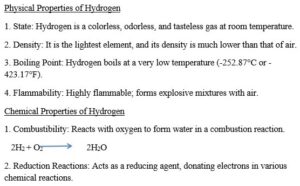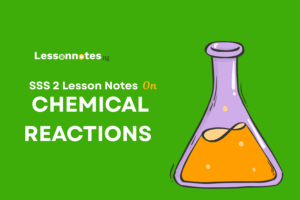Non Metals: Hydrogen SS2 Chemistry Lesson Note
Download Lesson NoteTopic: Non Metals: Hydrogen
Hydrogen is the chemical element with the symbol H and atomic number 1. It is the lightest and most abundant element in the universe, constituting about 75% of its elemental mass. In its most common form, hydrogen is a colourless, odourless, and highly flammable diatomic gas (H₂). It plays a crucial role in various industrial processes, and energy production (e.g., fuel cells), and is a fundamental building block of molecules, such as water (H₂O) and hydrocarbons.
The electronic configuration of hydrogen is 1s¹, indicating that it has one electron occupying the 1s orbital and a possible oxidation number of +1 when it forms a cation (H⁺) by losing its electron, and -1 when it forms an anion (hydride ion, H⁻) by gaining an electron.
Hydrogen is located in Group 1 and Period 1 of the periodic table. As the first element, it is positioned at the top left corner. While it shares some characteristics with alkali metals in Group 1, hydrogen is not a metal; it is a nonmetal. Its placement on the periodic table reflects its unique properties and serves as a bridge between alkali metals and halogens.
ISOTOPES OF HYDROGEN
Hydrogen has three isotopes:
- Protium (¹H): This is the most common isotope of hydrogen, consisting of one proton and no neutrons.
- Deuterium (²H): This is a stable isotope of hydrogen, consisting of one proton and one neutron.
- Tritium (³H): This is a radioactive isotope of hydrogen, consisting of one proton and two neutrons. It is relatively rare and is often used in various applications, including some types of nuclear reactions and research.

Formation of Hydrides: Reacts with many metals to form hydrides, such as sodium hydride (NaH).
- Isotopic Exchange: Hydrogen atoms in molecules can exchange with deuterium or tritium in specific reactions.
USES OF HYDROGEN
Hydrogen has several important uses in various industries:
- Ammonia Production: Used in the Haber-Bosch process for the synthesis of ammonia, a crucial component in fertilizer production.
- Hydrogenation of Oils: Employed in the food industry to hydrogenate vegetable oils, converting liquid oils into solid or semi-solid fats.
- Fuel Cells: Utilized as a clean energy source in fuel cells, where hydrogen reacts with oxygen to produce electricity, with water as the byproduct.
- Rocket Fuel: Used as a propellant in the space industry for rockets and spacecraft.
- Metal Production: Employed in the reduction of metals from their ores, such as the production of metallic iron from iron ore.






















